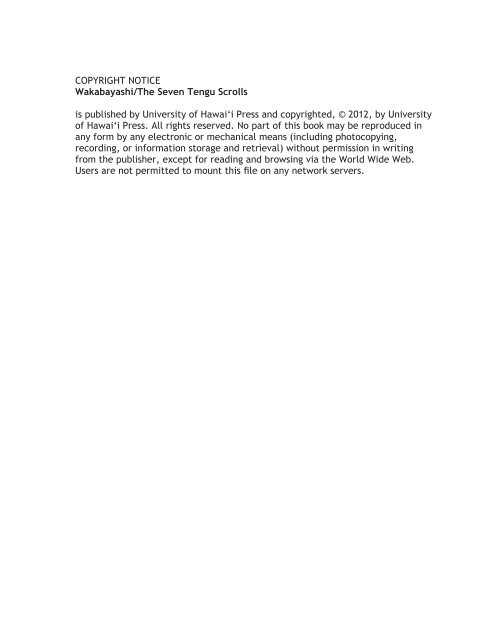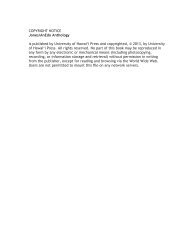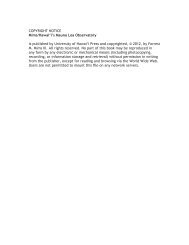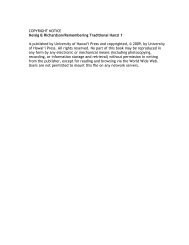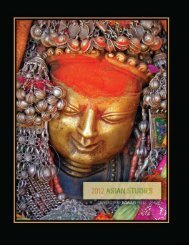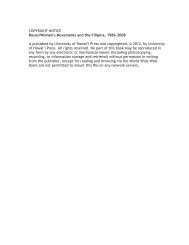COPYRIGHT NOTICE Wakabayashi/The Seven Tengu Scrolls is ...
COPYRIGHT NOTICE Wakabayashi/The Seven Tengu Scrolls is ...
COPYRIGHT NOTICE Wakabayashi/The Seven Tengu Scrolls is ...
You also want an ePaper? Increase the reach of your titles
YUMPU automatically turns print PDFs into web optimized ePapers that Google loves.
<strong>COPYRIGHT</strong> <strong>NOTICE</strong><br />
<strong>Wakabayashi</strong>/<strong>The</strong> <strong>Seven</strong> <strong>Tengu</strong> <strong>Scrolls</strong><br />
<strong>is</strong> publ<strong>is</strong>hed by University of Hawai‘i Press and copyrighted, © 2012, by University<br />
of Hawai‘i Press. All rights reserved. No part of th<strong>is</strong> book may be reproduced in<br />
any form by any electronic or mechanical means (including photocopying,<br />
recording, or information storage and retrieval) without perm<strong>is</strong>sion in writing<br />
from the publ<strong>is</strong>her, except for reading and browsing via the World Wide Web.<br />
Users are not permitted to mount th<strong>is</strong> file on any network servers.
Introduction<br />
In the spring of the ninth year of Emperor Jomei (637), on the twenty-third<br />
of the second month, a large star shot across the sky from east to west.<br />
<strong>The</strong>n there was a sound similar to that of thunder. <strong>The</strong> people said it was<br />
the sound of a shooting star. Others said it was earth-thunder. <strong>The</strong>reupon,<br />
the monk Min said it was not a shooting star, but a celestial dog; its barking<br />
sounds like thunder.<br />
nihon shoki 1<br />
<strong>The</strong> mythological creature known as tengu has had a long and complicated<br />
h<strong>is</strong>tory in Japan. <strong>The</strong> earliest known reference to tengu in Japan <strong>is</strong> found<br />
in the eighth-century Nihon shoki (<strong>The</strong> Chronicles of Japan). <strong>The</strong> word<br />
“tengu” originated in China, where tian gou, as its literal meaning “celestial<br />
dog” suggests, refers to a comet or an animal. 2 <strong>The</strong> tengu popularly known<br />
in Japan today have beaks or long noses, wings, and human bodies, and are<br />
often d<strong>is</strong>gu<strong>is</strong>ed as yamabushi (mountain ascetics). Yamabushi themselves<br />
worship tengu as guardians of the mountains, where much of the mountain<br />
ascetics’ religious training takes place. Festivals honoring tengu are held at<br />
various temples throughout the country, many of which are located in or<br />
near mountains and are centers of shugendō, the order of mountain ascetics.<br />
In traditional Japanese folktales, tengu are usually depicted as forest<br />
spirits or deities. <strong>The</strong>y can be m<strong>is</strong>chievous (kidnapping children from<br />
xiii
villages) or comical (playing tricks on people who wander into the mountains).<br />
Sometimes they are outwitted by humans. In a popular folktale, a<br />
tengu <strong>is</strong> fooled by a child into trading h<strong>is</strong> treasured kakuremino (a straw<br />
raincoat that grants its wearer inv<strong>is</strong>ibility) for an ordinary bamboo tube<br />
that the child claims <strong>is</strong> a telescope. <strong>Tengu</strong> also are known for their supernatural<br />
powers, and unusual phenomena are attributed to them. When a<br />
tree in the forest unexpectedly falls, it <strong>is</strong> referred to as a tengu daoshi (tengu<br />
knockdown), inexplicable laughter heard in the woods <strong>is</strong> called tengu warai<br />
(tengu laughter), hail <strong>is</strong> known as tengu tsubute (tengu stones), and a sudden<br />
gust <strong>is</strong> a tengu kaze (tengu wind). 3<br />
Studies of tengu date back to the work of Tokugawa (1603–1868)<br />
scholars Ogyū Sorai, Hiraga Gennai, and Hirata Atsutane, and novel<strong>is</strong>t<br />
Takizawa Bakin. During the Meiji (1868–1912), philosopher and folklor<strong>is</strong>t<br />
Inoue Enryō wrote the <strong>Tengu</strong>-ron (<strong>The</strong> <strong>Tengu</strong> <strong>The</strong>ory) as part of h<strong>is</strong> series<br />
of studies on Japanese demons and goblins. In 1908, M. W. de V<strong>is</strong>ser contributed<br />
an article on tengu in Engl<strong>is</strong>h to the Asiatic Society of Japan. <strong>The</strong>se<br />
and more-recent publications by Chigiri Kōsai are the most comprehensive<br />
studies available on tengu.<br />
In h<strong>is</strong> “Yama no jinsei” (Life of the Mountains) and other works,<br />
Yanagita Kunio grouped tengu with other legendary forest creatures such as<br />
yama otoko (mountain men), yama onna (mountain women), and foxes, all<br />
of which are linked to strange occurences in the mountains. 4 Yanagita was<br />
primarily interested in the development of folk beliefs in the life and h<strong>is</strong>tory<br />
of mountain people. He suggested that tengu were one of several images of<br />
mountain dweller created by villagers. Miyake Hitoshi, Miyamoto Kesao,<br />
and Carmen Blacker have mentioned tengu in relation to mountain worship,<br />
shugendō, and yamabushi. 5<br />
Scholarly works on tengu, primarily by folklor<strong>is</strong>ts and scholars of popular<br />
religion, have been attempts to define the origins and character<strong>is</strong>tics of<br />
tengu as they appear in folk tales and beliefs. However, in an effort to define<br />
tengu, scholars have overlooked the social and h<strong>is</strong>torical significance of the<br />
wide variety of representations of tengu and its transformations. In addition,<br />
very few h<strong>is</strong>torians have deemed mythical creatures such as tengu worthy<br />
of serious study. Most of the previously mentioned images of tengu that<br />
prevail in modern Japanese folk tradition are creations of the fifteenth and<br />
sixteenth centuries, or later. <strong>The</strong> earlier medieval period, however, presents<br />
tengu quite differently. <strong>Tengu</strong> assume surpr<strong>is</strong>ingly diverse forms in Buddh<strong>is</strong>t<br />
didactic literature, h<strong>is</strong>tories, war chronicles, diaries, popular and court literature,<br />
and narrative scroll paintings. <strong>Tengu</strong> appear not only as mountain<br />
creatures and comets, but also as vengeful spirits that seek to bring chaos to<br />
anyone who caused them suffering, or as enemies of Buddh<strong>is</strong>m who defy or<br />
xiv introduction
plague Buddh<strong>is</strong>t priests and m<strong>is</strong>lead people with their magic tricks. <strong>The</strong>y<br />
also appear as Buddh<strong>is</strong>t priests who failed to achieve nirvana and so were<br />
relegated to the “realm of tengu” for their conceit and worldly attachment.<br />
What, then, are tengu? Instead of attempting to define these mythological<br />
creatures for which there clearly ex<strong>is</strong>ts no single identity, th<strong>is</strong> book will explore<br />
through them the world in which they were created.<br />
<strong>Tengu</strong> and Evil in Medieval Japan<br />
<strong>The</strong> medieval period in Japan <strong>is</strong> generally known for chronic social d<strong>is</strong>order<br />
and instability, caused by the r<strong>is</strong>e of the warrior class, frequent warfare, and<br />
an absence of political unity and continuity. Religion, too, underwent dramatic<br />
changes. With the widespread notion that the world was approaching<br />
the last stage in the dem<strong>is</strong>e of the Buddha’s teaching came new interpretations<br />
and practices within the traditional order in preparation for the “Final<br />
Age.” <strong>Tengu</strong> that appeared during th<strong>is</strong> period were usually symbolic of evil<br />
or chaos. <strong>The</strong>y were used by some to explain social d<strong>is</strong>turbances and condemn<br />
political enemies, and by others to justify religious views. An analys<strong>is</strong><br />
of tengu can give us a better understanding of the plural<strong>is</strong>tic nature of the<br />
values and beliefs of different classes during th<strong>is</strong> turbulent period than can<br />
any attempt to examine the various segments of society directly.<br />
In th<strong>is</strong> work, I have chosen to concentrate on tengu from the late Heian<br />
(897–1185) to the late Kamakura (1185–1333), especially on tengu as a<br />
manifestation of Māra or ma, the personification of the Buddh<strong>is</strong>t concept<br />
of evil symbolizing obstacles to be overcome on the path to enlightenment. 6<br />
“Evil” as d<strong>is</strong>cussed here does not necessarily refer to moral evil (aku), but<br />
rather to temptations of desire and passion that hinder one from attaining<br />
enlightenment. In th<strong>is</strong> sense, evil <strong>is</strong> the antithes<strong>is</strong> of the Buddha or Buddh<strong>is</strong>m.<br />
It may also refer to the more universal “evil” of pain and suffering,<br />
m<strong>is</strong>fortune, natural d<strong>is</strong>aster, or social d<strong>is</strong>order, and to the unequal d<strong>is</strong>tribution<br />
of suffering or fortune. 7 <strong>The</strong>se are problems that ex<strong>is</strong>t in all societies<br />
at all times; religions endeavor to offer explanations, such as divine pun<strong>is</strong>hment,<br />
malevolent spirits, or predestined fate. Religions also offer solutions<br />
to these problems: be a moral person, venerate the god(s) or spirits,<br />
perform proper rituals. Yet such explanations and solutions are not always<br />
convincing, and the suggested remedies not always effective.<br />
In Buddh<strong>is</strong>m, evil <strong>is</strong> often explained as a predestined consequence<br />
of karma—or acts from one’s previous lives—which operates within the<br />
continuous cycle of death and rebirth. Yet people do not always readily<br />
admit their karmic fate. Demonic figures continued to appear in Hindu<br />
and Buddh<strong>is</strong>t myths as external causes for suffering and evil that cannot be<br />
introduction xv
explained. One of these figures, Māra, originally an evil deity from Indian<br />
folklore, was incorporated into the Buddh<strong>is</strong>t cosmology. Māra not only<br />
brought pain and m<strong>is</strong>fortune, but also obstructed the Way of the Buddha.<br />
Thus Māra was designated the antithes<strong>is</strong> of the Buddha—more so than any<br />
other demonic figure in Buddh<strong>is</strong>t mythology. 8 In medieval Japanese texts,<br />
tengu as Māra often physically challenged Buddh<strong>is</strong>t monks, created temptations<br />
in the minds of the trainees, caused natural d<strong>is</strong>asters such as whirlwinds,<br />
were sources of illness and death, and provoked social d<strong>is</strong>turbances<br />
and war.<br />
Other demonic creatures representing evil can be found in medieval<br />
Japanese literature, the most obvious being oni (often translated as “ogre”)—<br />
and not all tengu images fit into any one category. Focusing on a particular<br />
dimension of tengu r<strong>is</strong>ks undermining its plural<strong>is</strong>tic nature, but there are<br />
several good reasons for doing so. First, tengu as a manifestation of ma <strong>is</strong> the<br />
most predominant representation of tengu in medieval Japan as far as literary<br />
sources of the period are concerned. Th<strong>is</strong> <strong>is</strong> not surpr<strong>is</strong>ing because Buddh<strong>is</strong>t<br />
thought and institutions played a major role in the religious, intellectual,<br />
social, and political life of the times. Nevertheless, Buddh<strong>is</strong>t images of<br />
tengu have not formed the bas<strong>is</strong> of any study of tengu until now. Second, th<strong>is</strong><br />
book investigates not only tengu images, but also the concept and use of evil<br />
in medieval Japan. Representations of evil are often constructed to explain<br />
phenomena that d<strong>is</strong>rupt society. Identifying those who d<strong>is</strong>turb social order<br />
as evil (usually challengers or defiers of authority) legitimizes the institution<br />
seeking to determine that order. Through a close examination of tengu, we<br />
will see what Buddh<strong>is</strong>t institutions defined as evil and how they used the<br />
rhetoric of evil to justify their own positions and marginalize others’. Finally,<br />
although focusing on a single dimension of tengu, th<strong>is</strong> work will also deal<br />
with a variety of tengu images that evolved as symbols of ma over several<br />
centuries. <strong>The</strong> dimension of tengu d<strong>is</strong>cussed in th<strong>is</strong> book <strong>is</strong> in itself a plurality<br />
that reveals the diversity and complexity of Buddh<strong>is</strong>t notions of evil.<br />
“Reading” the <strong>Tengu</strong> zōshi<br />
Th<strong>is</strong> book <strong>is</strong> divided into two parts: Part 1, “<strong>Tengu</strong> and Buddh<strong>is</strong>t Concepts<br />
of Evil,” d<strong>is</strong>cusses Buddh<strong>is</strong>t appropriations of tengu in the late twelfth and<br />
thirteenth centuries in relation to the concept of ma. Chapter 1 explores the<br />
transformation of tengu from a possessing spirit rooted in indigenous folk<br />
beliefs to a symbol of ma that can only be conquered by Buddh<strong>is</strong>t monks,<br />
and looks at how the latter became firmly establ<strong>is</strong>hed by the late Heian. <strong>The</strong><br />
concepts of madō and tengudō, developed by the Buddh<strong>is</strong>t clergy as one<br />
of the many solutions to the degenerations of the Final Age, are examined<br />
xvi introduction
in Chapter 2. <strong>The</strong>se early chapters demonstrate how ma, as much as it <strong>is</strong> a<br />
religious construct, <strong>is</strong> also a social construct. Multiple interpretations of<br />
ma developed in response to social changes and challenges to the Buddh<strong>is</strong>t<br />
community. <strong>Tengu</strong>, too, were assigned numerous images in response to the<br />
challenges faced by Buddh<strong>is</strong>m to bolster its legitimization.<br />
Part 2 focuses on the <strong>Tengu</strong> zōshi. Also known as the Shichi tengu-e<br />
(<strong>Seven</strong> <strong>Tengu</strong> <strong>Scrolls</strong>), the <strong>Tengu</strong> zōshi <strong>is</strong> a set of narrative scrolls (emaki)<br />
dated to A.D. 1296. It cons<strong>is</strong>ts of the Kōfukuji, Tōdaiji, Enryakuji, Onjōji,<br />
and Tōji (which includes scenes from Daigoji and Kōyasan) scrolls, and the<br />
two so-called “Miidera” scrolls. 9 <strong>The</strong> first five scrolls, as their titles suggest,<br />
refer to prominent Buddh<strong>is</strong>t temples in Nara and Kyoto, and each depicts<br />
its monks as tengu. <strong>The</strong> first of the two Miidera scrolls begins with three<br />
short tales about tengu, followed by a scene in which Ippen (1239–1289),<br />
the founder of the new Ji school of Pure Land Buddh<strong>is</strong>m, and the itinerant<br />
Zen monk Jinen Koji (literally the Layman Jinen; d.u.), appear as tengu. <strong>The</strong><br />
final scroll begins with a scene in which tengu from every sect gather and<br />
resolve to build a temple, engage in practice, and attain buddhahood. <strong>The</strong><br />
work concludes by stating that all have achieved salvation.<br />
<strong>The</strong> <strong>Tengu</strong> zōshi has been studied not only by art h<strong>is</strong>torians, but also by<br />
scholars of h<strong>is</strong>tory, religion, and literature as a source of insight into Buddh<strong>is</strong>m<br />
and late Kamakura society. Kuroda Hideo, Imai Masaharu, Kanai<br />
Kiyomitsu, and others interested in Ippen and the “new” Kamakura Buddh<strong>is</strong>m<br />
have examined the scenes in which Ippen appears in the Miidera A<br />
scroll. 10 <strong>The</strong> depiction of Jinen Koji has aroused the interest of h<strong>is</strong>torians of<br />
Zen as well as h<strong>is</strong>torians of the performing arts, especially in reference to<br />
the Nō play Jinen Koji. 11 A brief reference in the Miidera A scroll has been<br />
noted by Amino Yoshihiko as the earliest source for the term “eta” for hinin<br />
(outcast), and the scene of the eta child catching a kite (a bird of prey) by<br />
the river has been widely reproduced in h<strong>is</strong>tories of eta-hinin. 12 <strong>The</strong> depictions<br />
of temple activities such as the Sakura-e at Daigoji, ritual dances<br />
(ennenmai and dengaku) at Kōfukuji and Onjōji, as well as the numerous<br />
assembly (da<strong>is</strong>hu sengi) scenes, have been studied by social and cultural<br />
h<strong>is</strong>torians of medieval Buddh<strong>is</strong>m. 13<br />
Nevertheless, most <strong>Tengu</strong> zōshi studies have only touched on one or<br />
two segments of the scrolls. Moreover, those scholars who have examined<br />
them in depth have focused primarily on how “new” Buddh<strong>is</strong>m <strong>is</strong> represented<br />
in the scrolls. Th<strong>is</strong> has much to do, first, with the current trend in<br />
studies on Kamakura Buddh<strong>is</strong>m and, second, with the lack of establ<strong>is</strong>hed<br />
methodology for the extensive use of v<strong>is</strong>ual materials such as emaki for<br />
h<strong>is</strong>torical analys<strong>is</strong>. More-comprehensive studies of the <strong>Tengu</strong> zōshi are now<br />
available, owing to the work of scholars of religious h<strong>is</strong>tory and literature<br />
introduction xvii
such as Harada Masatoshi, Abe Yasurō, M<strong>is</strong>umi Yōichi, and Makino Junji;<br />
the d<strong>is</strong>covery of copies of the scrolls’ text at the Kanazawa Bunko Library<br />
by Takahashi Shūei; and recent work by art h<strong>is</strong>torian Tsuchiya Takahiro. 14<br />
Close scrutiny of the scrolls’ content and context suggests that they were<br />
most likely produced by those belonging to or closely associated with establ<strong>is</strong>hed<br />
Buddh<strong>is</strong>t schools: their critic<strong>is</strong>m of the religious community clearly<br />
stems from th<strong>is</strong> point of view. It <strong>is</strong> therefore essential to pay attention<br />
to the presentation of these schools in the scrolls. At the time they were<br />
made, Buddh<strong>is</strong>t institutions were confronting grave challenges. In addition<br />
to the spread of new and popular schools of Buddh<strong>is</strong>m, serious reform<br />
movements emerged from within, led by people like Jōkei (1155–1213) and<br />
Myōe (1173–1232) of the traditional Hossō and Kegon sects, respectively.<br />
<strong>The</strong> <strong>Tengu</strong> zōshi must be studied within its social and intellectual contexts if<br />
we are to understand its true place and meaning in the h<strong>is</strong>tory of medieval<br />
Japan.<br />
<strong>The</strong> analys<strong>is</strong> of the <strong>Tengu</strong> zōshi presented here owes much to the recent<br />
development of h<strong>is</strong>torical iconology (kaiga shiryōron) in the field of Japanese<br />
h<strong>is</strong>tory and the pioneering work of Kuroda Hideo. 15 In recent years,<br />
several h<strong>is</strong>torians of medieval Japan have been experimenting with various<br />
approaches to the use of art, employing v<strong>is</strong>ual materials such as portraits,<br />
pictorial maps, and narrative scrolls as documents that must be critically<br />
“read” and analyzed within their h<strong>is</strong>torical and social contexts. 16 Critical<br />
reading of pictures allows us to better comprehend manners, behavior, and<br />
conduct reflecting social status and profession, to gain an understanding of<br />
“space” as revealed in the h<strong>is</strong>torical landscape, and to perceive general mentality<br />
and ways of thinking. However, as Kuroda notes, no clear methodology<br />
has yet to be establ<strong>is</strong>hed, and many h<strong>is</strong>torians still neglect the serious<br />
reading of v<strong>is</strong>ual sources, d<strong>is</strong>m<strong>is</strong>sing them as fictions that cannot be used<br />
as credible h<strong>is</strong>torical evidence. <strong>The</strong> four chapters dealing with the <strong>Tengu</strong><br />
zōshi presented here demonstrate the ways in which illustrated narrative<br />
scrolls can be used as primary sources to offer new insights into the period<br />
under study.<br />
As with any document, we must first comprehend the <strong>Tengu</strong> zōshi’s<br />
general content, and so that content <strong>is</strong> outlined in Chapter 3. Although the<br />
scrolls do not ex<strong>is</strong>t in their complete, original form, th<strong>is</strong> chapter attempts<br />
to grasp their overall structure and composition in light of other surviving<br />
variant texts. Detailed analys<strong>is</strong> of each scroll <strong>is</strong> also included. Next, to<br />
identify accurately what <strong>is</strong> being depicted in the paintings, we must comprehend<br />
the culturally and h<strong>is</strong>torically specific way of seeing expressed in<br />
them. Only by understanding the various meanings of tengu that ex<strong>is</strong>ted<br />
at the time of its production can we truly grasp the meaning of the <strong>Tengu</strong><br />
xviii introduction
zōshi. Thus the examination in Chapters 1 and 2 of the different notions of<br />
tengu that developed prior to the production of the scrolls <strong>is</strong> essential for a<br />
close reading of the scrolls. For example, in Chapter 4, which d<strong>is</strong>cusses the<br />
use of tengu images to critique Buddh<strong>is</strong>m during the Kamakura, a careful<br />
look at the scrolls reveals that the author makes d<strong>is</strong>tinctions between anti-<br />
Buddh<strong>is</strong>t and tengudō images to express the difference in the nature and<br />
degree of critic<strong>is</strong>m leveled against establ<strong>is</strong>hed and new Buddh<strong>is</strong>t schools.<br />
Th<strong>is</strong> d<strong>is</strong>covery, however, <strong>is</strong> not possible without prior knowledge of the<br />
diversity of tengu images that ex<strong>is</strong>ted at the time (the Kamakura period,<br />
or late thirteenth century). In conjunction with contemporary h<strong>is</strong>torical<br />
sources and literature, Chapter 4 further identifies the specific practices of<br />
late-Kamakura Buddh<strong>is</strong>t monks being criticized in the scrolls.<br />
Chapter 5 addresses the question of the authorship of the <strong>Tengu</strong> zōshi.<br />
Although attributing the scrolls to a specific individual may not be possible,<br />
an attempt to identify the author may reveal the circumstances under<br />
which the scrolls were made and lead us to d<strong>is</strong>cover meanings in the images<br />
and text that may not otherw<strong>is</strong>e be apparent. In addition to certain<br />
v<strong>is</strong>ual and verbal representations that clearly express a specific position<br />
and motivation, such speculation may ultimately uncover a line of thinking<br />
that directs us to the author. In the case of the <strong>Tengu</strong> zōshi, addressing the<br />
question of authorship prompts further analys<strong>is</strong> of the conflict between the<br />
two major temples depicted in the scrolls—Enryakuji and Onjōji—and the<br />
manipulation of Buddh<strong>is</strong>t ideologies to legitimize the superiority of one<br />
over the other.<br />
Chapter 6, the final chapter on the <strong>Tengu</strong> zōshi, explores the meaning<br />
of ma as presented in the scrolls through an analys<strong>is</strong> of v<strong>is</strong>ual and textual<br />
representations of tengu. <strong>The</strong> thirteenth century saw the r<strong>is</strong>e of “original<br />
enlightenment thought” (hongaku sh<strong>is</strong>ō), a teaching known for its extreme<br />
nondual<strong>is</strong>m between opposites such as man and woman, buddha and layperson,<br />
good and evil. According to the original enlightenment thought,<br />
monks belonging to the realm of tengu are entitled to buddhahood because<br />
ma and the Buddha are one and the same. Understanding the d<strong>is</strong>course of<br />
original enlightenment and its presentation in the concluding scroll reveals<br />
that the author’s intention in producing the <strong>Tengu</strong> zōshi was above all to<br />
urge reform within orthodox Buddh<strong>is</strong>m.<br />
In sum, a close analys<strong>is</strong> of the <strong>Tengu</strong> zōshi helps us v<strong>is</strong>ualize one aspect<br />
of the critique of Kamakura Buddh<strong>is</strong>m and how tengu images were<br />
used to express th<strong>is</strong> in the late thirteenth century. At the same time, the<br />
varying images and the dilemma embedded in them—of Buddh<strong>is</strong>m as a<br />
way to conquer tengu versus Buddh<strong>is</strong>m embracing monks that become<br />
tengu—embody the challenges faced by establ<strong>is</strong>hed Buddh<strong>is</strong>t institutions of<br />
introduction xix
the period. <strong>The</strong> conclusion reexamines the meaning of tengu and th<strong>is</strong> “dilemma”<br />
and d<strong>is</strong>cusses in broader context how ma, the Buddh<strong>is</strong>t concept of<br />
evil <strong>is</strong>, after all, socially constructed not only to explain problems that ex<strong>is</strong>t<br />
in the world, but also to justify the ex<strong>is</strong>tence of an institution that depends<br />
on its presence to survive. Through a reading of tengu images from the<br />
above viewpoints, th<strong>is</strong> book ultimately examines the rhetoric of legitimacy<br />
used by Buddh<strong>is</strong>ts in medieval Japan.<br />
xx introduction


